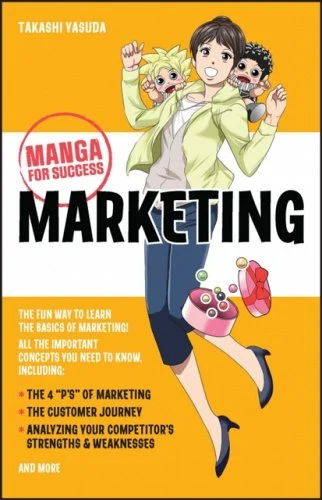I loved the concept for this book but I’m a sucker for Japanese culture. A combination of Manga and Marketing plays to two things I love.
I did wonder who they were targeting and what the pitch was? It can’t just be Japanese lovers like me. I also wondered to what depth they would go?
The cover answers my queries — ‘A fun and approachable way to learn the basics of marketing.‘ Simple, direct pitch that explains what it’s trying to do and who it is targeted at (someone learning the basics).
Expectations set, I dived in. I enjoyed the first section and the introduction of the God of Misfortune and our two main teachers the Angels of Marketing — Emo and Logi, close to a concept of Emo-Funcky which we have used for years.
The Manga sections continue to be fun, light-hearted interludes, but the book becomes a bit more of a textbook, with the text and tables sections doing a lot of the explaining. This does provide the space and means to explain some of the concepts better but I did find my self-waiting impatiently for the next Manga section.
I was also less certain about some of definitions and tools in the text sections. Some of the definitions seemed a little narrow, for example Yasuda says ‘Marketing is a communication method and tool that you can use to propose products and services that people can buy and be satisfied with.‘
Some of the concepts it pushes are the traditional (and some would say outdated) ones — AIDA which is dressed up as AIDMA — Attention, Interest, Desire, Memory and Action and the 4Ps of marketing. However, in most cases the text sections also go into more detail and includes more up-to-date models.
One question it sets but ducks, is the age-old one of what is a brand? It defaults to defining brand recognition and brand association. Given finding a good definition of a brand can be difficult and controversial perhaps, I wasn’t too surprised
The other double-edged sword the book has to contend with is the amount it wants to deal with, and the need to keep it succinct and approachable. Overall, it handles the balancing act pretty well.
So all in all, what do I think?
Well, I wish I could draw better than I can, as I would have sketched out a short Manga strip to sum up my feelings. It would also reflect on my overall conclusion, which is there probably isn’t quite enough Manga, but an awful lot of marketing crammed into a few pages. However Manga for Success lives up to its pitch — it is a fun and approachable way to introduce the basics of marketing and would be good for someone starting out in Marketing or indeed as a book for students doing business studies at school.
Featured image: Jarmo Piironen / Jamoimages



































